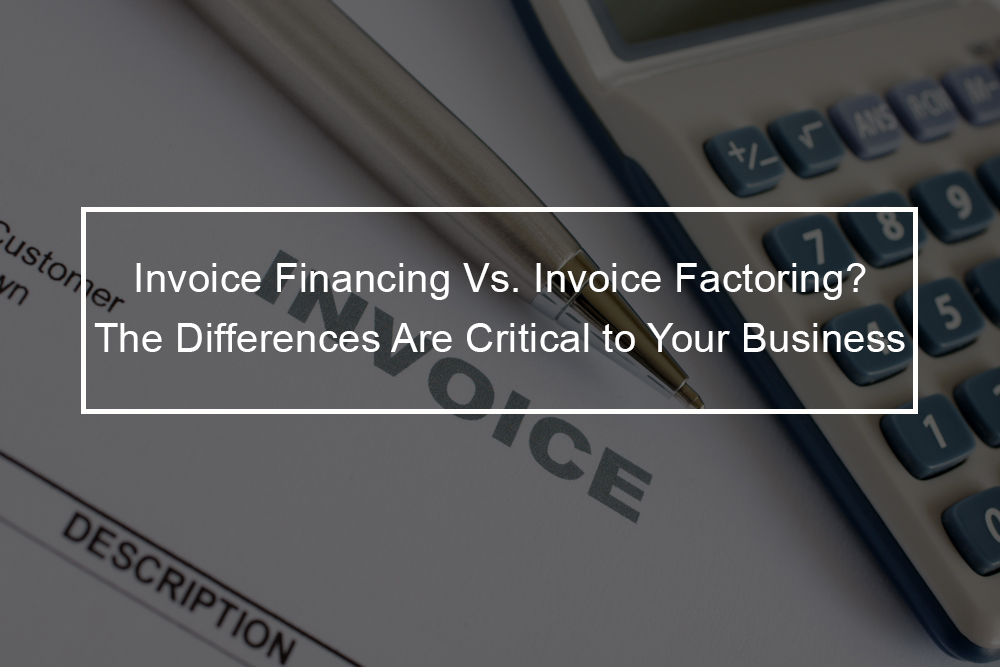Unpaid invoices can be a challenge for any company. Whereas you know that the cash from the invoices will come eventually, slow-paying clients or long repayment terms can have a negative effect on your incoming cash flow — and this could be a challenge for your business.
Rather than waiting weeks (or even months) to receive the money owed to your company, how can you get the financing your business needs instantly? What if you can make your unpaid invoices to work for your business? What if you could trade your unpaid invoices or utilize those invoices as collateral to get the money you need to cover an emergency or to use as working capital? If outstanding invoices are causing cash flow issues for your business, there are lending solutions available for you. In this post, we’ll explore invoice financing and invoice factoring. We’ll discuss the differences, how they can benefit your business, associated costs, and, most importantly, how to make the appropriate decision for your company. Read on to learn more.
What Is Invoice Factoring?
Invoice factoring, known also as accounts receivable factoring, is where a business owner sells unpaid invoices to a lender. This lender is referred to as a factoring company or simply a “factor.” When the business owner sells the invoice, the factor provides an upfront payment that is typically 85-percent to 95-percent of the invoice total.
The factoring company will then proceed with collecting payment from the client. After the customer has paid the invoice, the factoring company will pay the remaining balance to the business owner, less an agreed-upon invoice factoring fee. Factor fees vary from one lender to another; however, they typically add up to between one percent and six percent per month. Factoring companies charge monthly, daily, or weekly fees, so the longer it takes for the invoice to be paid, the more fees you will pay.
Certainly, the factoring fee reduces the amount that you receive from the invoice. This’s the reason it is essential to always weigh out the return on investment before agreeing to sell your invoices. If there isn’t an immediate funding need, waiting for your client to pay the invoice is the wisest choice. However, if unpaid invoices are causing financial constraints for your business, receiving immediate cash might be worth the cost.
Invoice factoring provides a financial solution for businesses that require funds faster but may not be eligible for other loan options. Most business loans require a minimum annual revenue, a certain time in business, and many lenders also consider personal credit scores. However, even if your annual revenues are low, your company is new, or you have personal credit challenges, you might qualify for invoice factoring — as long as you have qualifying invoices.
What is invoice financing?
Otherwise called accounts receivable financing, invoice financing denotes borrowing cash against your outstanding accounts receivables. A lender offers you a portion of your unpaid invoices—often 80-percent to 90-percent—up front, in the form of a business line of credit or loan. After your client pays the invoice, you will pay the lender back the amount loaned, including interest and fees. In this case, your company is still responsible for collecting outstanding money owed by your customers.
In some situations, the invoice financing provider syncs up with your accounts receivable systems behind the scenes. After your client pays the invoice, they may automatically minus their fees before forwarding you the balance. Typically, invoice financing is ideal for businesses that need money faster and feel confident they can collect on the outstanding invoices owed to them by their clients.
Invoice factoring versus invoice financing
The key difference between invoice financing and invoice factoring is who collects on the business’s unpaid invoices. With invoice financing, the client maintains full control of money collections. With invoice factoring, the factoring company or factor buys the unpaid invoices and is responsible for collections. In both scenarios, businesses are advanced around 80-percent of their unpaid invoices upfront, with the remaining funding (deduct fees) coming after the client has paid the invoice.
If you are a small business owner pressured by outstanding accounts receivables, you are certainly not alone. Over 60-percent of invoices are paid late, and 20-percent are over two weeks late. Generally, late payments can cause a cash shortage, preventing you from making rent, paying your staff, or moving forward on vital business opportunities. Both invoice factoring and invoice financing are possible options for dealing with slow cash flow. Nonetheless, invoice financing and invoice factoring differ in significant ways when it comes to how payment is collected from the client and the structure of the financing.
Advantages of Invoice financing and invoice factoring
Whether you are utilizing invoice factoring or invoice financing, there are some advantages to this kind of business finance—mainly that it can smooth out cash flow problems very fast. Businesses can use invoice factoring and financing to pay regular bills and employees without having to wait for payment on outstanding invoices from customers. Moreover, whether you are using invoice financing or invoice factoring, it might be the only solution available to you if you cannot get other types of business financing. Because these lenders look more at your invoices and less at your credit and company’s financial health, you might find this kind of financing easier to qualify than others.
An advantage of invoice factoring, in particular, is that it warrants at least some of your outstanding accounts receivables and gets rid of the headache of money collections from the already busy life of a business owner. Provided your company deals with many unpaid invoices or late-paying clients, invoice factoring can be an option to make sure that you do get at least some of what is owed to you, providing you the cash your business needs to stay afloat.
Something else to note about invoice factoring is your company’s limited risk of not collecting outstanding payments. After the factoring company takes over the task of collecting the receivables and having your cash in hand, they are taking over the risk that your clients will not pay. Contrarily to a business loan, where you have to make payments, whether your customers pay you or not, invoice factoring removes that risk from your books.
Disadvantages of invoice financing and invoice factoring
Whereas invoice financing might appear like a fast and simple way to deal with cash flow issues, it can be costly, mainly since your fees will be dependent on when the client pays you back. Generally, a certain percentage—around one-percent to 4.5-percent —is charged every month that the invoice remains outstanding.
Moreover, as we mentioned above, if you opt for the factoring financing route and the lender is responsible for collecting the outstanding amounts from your clients, there is no hiding the fact that you have entered into a factor agreement. This may be a signal to clients that your company is in trouble. Luckily, most factoring providers need your continued business; thus, they will try to keep things as discreet as possible and present themselves as a representative of your team.
Which is right for you?
Even if invoice factoring and invoice financing have similarities, there are cases when you should select one option over the other. Before you submit your invoices, keep the following considerations in mind:
Non-notification vs. notification
If a third-party lender buys your invoices through invoice factoring, your clients will be notified since the factoring company will be collecting payment. With invoice financing, you are collecting payment, as usual, so your clients will be unaware of a lender’s involvement. If you don’t want your clients to be notified by a third-party, choose an invoice financing.
Collecting Payments
For a smaller company it might not have the manpower to chase down clients for unpaid invoices. If you would opt for the lender to collect a payment, invoice factoring is the solution that would work best for you. It is essential to note that invoice factoring usually has higher fees. Nonetheless, the additional costs may be worth it as long as you do not have the time or resources to track down clients and collect payment. If you use invoice factoring and the factoring company collects payments, note that your customers will be notified of third-party engagement. If you want to avoid this, consider your other invoice financing.
Lump-sum vs. asset-backed line of credit
If you want to obtain a lump sum payment for your invoices, go for invoice factoring. With this option, you can obtain up to 95-percent of your invoice value upfront. If you prefer a more flexible option, consider applying for invoice financing. You will get a line of credit that is backed by your unpaid invoices. If unpaid invoices are dragging your company down, make your accounts receivable work for you. With invoice factoring and financing, you can receive the money you need, even when you don’t qualify for a traditional business loan. Consider what kind of financing would work best for you, then shop around for the most affordable fees. Also, select a lender based on the financial needs of your business.










